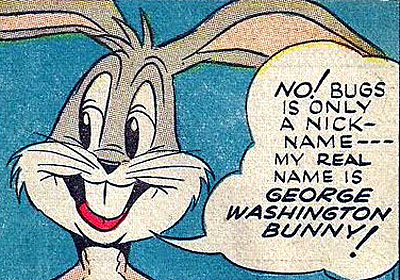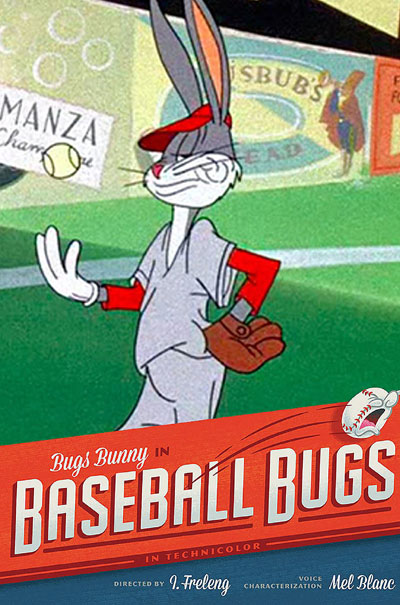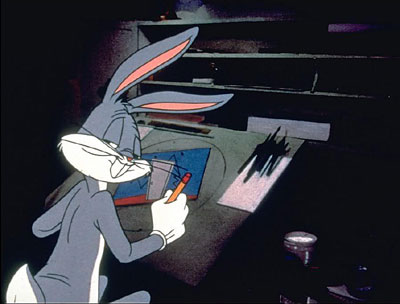|
#3: Bugs Bunny
Some people call me cocky and brash, but actually I am just self-assured. I'm nonchalant, imperturbable, contemplative. I play it cool, but
I can get hot under the collar. And above all I'm a very 'aware' character. I'm well aware that I am appearing in an animated cartoon. And sometimes I chomp on my carrot for the
same reason that a stand-up comic chomps on his cigar: it saves me from rushing from the last joke to the next one too fast. And I sometimes don't act, I react. And I always treat
the contest with my pursuers as 'fun and games.' When momentarily I appear to be cornered or in dire danger, and I scream, don't be consoined—it's actually a big put-on.
Let's face it Doc, I've read the script, and I already know how it turns out.—Looney Tunes animator Bob Clampett, speaking in first person as Bugs Bunny
I'm lookin' over
A three leaf clover
That I overlooked be-three.—Bugs Bunny happily singing to himself
Insouciant. Mischievous. Hilarious. A trickster with a heart of gold. Cute too. And unquestionably, indubitably American.
Bugs Bunny is a distillation of sensibilities which could only occur in the good ole U.S. of A., the wise-cracking creation of a brain-trust of
animators who ought to have their own Mt. Rushmore: Tex Avery, Bob Clampett, Isadore "Friz" Freleng, Chuck Jones, and Robert McKimson.
How much more American can you get? Take his real name. Bugs had his own comic book, Dell Publishing's Looney Tunes and Merrie Melodies.
In a March 1945 issue, Bugs explained to Porky and Petunia Pig that his real name is . . . George Washington Bunny.

And where's he from? Bugs hails from the heart of the heart of our country:
Brooklyn. According to Joe Adamson in his superb account of da wabbit, Bugs Bunny: 50 Years and Only One Grey Hare, our bunny was born in
Brooklyn in 1940. As a cartoon character, he's older by two years, but 1940 is when the last and most essential piece of his persona fell into place: the
voicing genius of Mel Blanc. Blanc said that Bugs has a Flatbush accent. So that settles it: Bugs is a Dodgers fan. Probably stuck with 'em even after
they moved because, you know, he's that kind of coney.

Bugs Bunny can trace his ancestry back to wily old Odysseus who wanted
no part of any excoision to Troy and tried feigning madness by sowing salt in his fields instead of carrot seeds. Still, who finally got the job done with a
giant Acme® Trojan Horse?
Bugs always operated on the principle that kept his hare out of the fire: Not
by strength, by guile. (In fact, it's da motto on the family escutcheon.)
He has the same refreshing irreverence as his American philosophical forbearers, Walt Whitman and Henry David Thoreau. He's no philistine,
but Europe's dusty laurels and empty pomp can't cow this rabbit. Here's Thoreau's take on so-called news from abroad; read it with a Flatbush
accent and it could just as easily be Bugs giving his nephew Clyde the straight dope:
As for Spain, for instance, if you know how to throw in Don Carlos and the Infanta, and Don Pedro and Seville and Granada, from time to time
in the right proportions,—they may have changed the names a little since I saw the papers,—and serve up a bull-fight when other
entertainments fail, it will be true to the letter, and give us as good an idea of the exact state or ruin of things in Spain as the most succinct
and lucid reports under this head in the newspapers: and as for England, almost the last significant scrap of news from that quarter was the revolution of 1649.
Left to his own devices, Bugs Bunny is a peace-loving rabbit. Three-time Academy Award-winning animator Chuck Jones said in a 1988 interview:
"It was very important that he be provoked, because otherwise he'd be a bully and we didn't want that. We wanted him to be a nice person."
And Bugs is a nice person—who's always getting provoked. In one of his greatest episodes, "Operation: Rabbit" from 1952, Bugs is at home,
probably listening to Red Barber and the Dodgers on the radio, when a persistent canine intrudes. The exchange is classic:
Bugs: Ehh, what's up, Doc?
Wile E.: Allow me to introduce myself. My name is Wile E. Coyote—genius. I am not selling anything nor am I working my way
through college.
Bugs: I —
Wile E.: So let's get down to cases: you are a rabbit and I am going to eat you for supper. Now don't try to get away. I am more muscular,
more cunning, faster and larger than you are and I'm a genius while you could hardly pass the entrance examinations to kindergarten.
Bugs: [yawns]
Wile E.: So, I'll give you the customary two minutes to say your prayers.
Bugs: I'm sorry Mac, the lady of the house ain't home and besides, we mailed you people a check last week! [slams Wile E.'s portable door
shut and smoothly descends as if atop an elevator down into his rabbit hole.]
*****
Many of my favorite Americans sport diverse résumés. Take Ted Williams.
He flew fighters in World War II, as well as in Korea, where he was John Glenn's wingman. He also had a pretty good baseball career. Or Kris
Kristofferson—now there's a life: Rhodes scholar; US Army captain and helicopter pilot; Country singer; Hollywood actor; bandmate and close
friend of Johnny Cash, Waylon Jennings, and Willie Nelson; and the songwriter who penned (and sang) "Help Me Make It Through the Night,"
"Sunday Mornin' Comin' Down," and "Me and Bobby McGee."
Well, Bugs Bunny could walk and chew carrot at the same time too. You
could say he's a regular Renaissance rabbit. For his military soivis in the 1943 episode "Super Rabbit," the United States Marine Corps made him an
honorary master sergeant (most rabbits would have to put in nearly 20 years to get three chevrons and three rockers.) He has a star on the
Hollywood Walk of Fame. And he was the first animated character to get his mug on a postage stamp (with all deference to that mouse from the West Coast.)
A jackrabbit of all trades, what can't he do? He's done a stint as a barber,
baseball player, chef, concert pianist, symphony conductor, train conductor, cowboy, doctor, pedicurist, private eyeball ("thugs thwarted, arsonists
arrested, bandits booked, forgers found, counterfeiters caught, and chiselers chiseled"), matador, organ grinder, and vaudeville star. He's
soived in the military (both the Army and the Marines), as well as behind bars. And he's a caring uncle, though a shaky tutor on the American Revolution.
And he's one rabbit with his priorities in order. He squares off against
Herman Göring, the head of the Luftwaffe, in "Herr Meets Hare." In "8 Ball Bunny" from 1950, he travels to the ends of the Oith to help little Playboy
Penguin (that's "peng-goo-win") get home to the South Pole (only to find that said penguin actually belongs in Hoboken.) And did Bugs resent being
used as a guinea rabbit launched to the moon? Well, yes, but it didn't stop him from saving our planet ("Haredevil Hare," 1948) when he discovers
that Marvin the Martian wants to blow it up. Bugs initially takes his usual laissez-faire attitude but then intervenes:
Bugs: Eh, what's up, Doc?
Marvin: "Oh, oh, I'm going to blow up the Earth.
Bugs: Yeah? Well, you sure picked a nice day for it. Hey, nice lookin' weepin [sic] you got there. Well, I'll be seein' you around, shorty.
[Walks away, and looking over his shoulder says] Now there's a brainy little guy. Probably get ahead in the moon. [Suddenly returns and,
peering over Marvin's shoulder, says] Eh, pardon me for bodderin' ya, Marconi, but eh, did you say you was goin' to blow up dee Oith?
Marvin: Oh, yes, I did.
Bugs: Yeah, that's what I thought ya said. Well, attee-ohs. [Walking away] One man's meat is anudder man's poison, I always say. After all,
it's his business if he wants to blow up dee Oith . . . Whoa! [returning to swipe the fuse out of Marvin's rocket] You can't do that! All the people I know are on dee Oith!
This cultured lapin provided many a kid's entrée to great music, such as
Rossini's opera in the 1950 gem, "Rabbit of Seville" and Wagner's Ring cycle in the 1957 masterpiece, "What's Opera, Doc?" Bugs also turns in a
fine rendition of Franz Liszt's "Hungarian Rhapsody No. 2" in the 1946 "Rhapsody Rabbit," a performance which prompted James Agee—a pretty cultured guy himself and The Nation's film critic—to write: "The best of it
goes two ways: one, very observant parody of concert-pianistic affectations; the other, brutality keyed into the spirit of the music to reach greater
subtlety than I have ever seen brutality reach before."
Ah yes, the violent cartoons canard. Once upon a time, cartoonists drew by
hand and their characters occasionally hit each other over the head with baseball bats or cast-iron skillets. Nowadays, the makers of so-called
cartoons—soulless computer-generated images—relentlessly hit their viewers over the head with morality lessons.
Just about any Looney Tunes episode has a dose of ethics somewhere, but
the beauty of Bugs Bunny—the thing that makes him one of my greatest Americans—is that he always entertains. He makes us laugh. It's show-biz,
kids, and he never loses sight of it. Matter of fact, the thing that puts Bugs head and floppy ears above his peers is that even in the middle of the
action he's aware that it's just a cartoon.
When it comes to bustin' the fourth wall, postmodernists got nothin' on Bugs!
In the classic "Hair-Raising Hare" from 1946, Bugs holds back a buckling
door with Gossamer snarling and pushing on the other side. Turning to the viewers, he pleads: "Is there a doctor in the house? Is there a doctor in the
house?" A black silhouette of a man in the audience pops up in the corner of the screen and, pointing at Bugs, announces: "I'm a doctor!" You know
what's coming, a perfect alley-oop of a gag which Bugs gets to slam-dunk. Stepping away from the door, he gestures with his carrot and asks with
extra relish: "Ehhh, what's up, Doc?"
But it's the 1953 "Duck Amuck," one of many masterpieces by Chuck Jones, that would've made Jimmy Joyce jealous. It features Daffy Duck, who
enters the action attired as a Musketeer. Just as he starts to touché, the scenery runs out behind him. A perplexed Daffy turns to the audience to
ask: "Whoever's in charge here, where's the scenery?" Paintbrushes render a new background, a farm, which irks Daffy a bit, but he dons a straw hat
and overalls only to stroll past an eskimo village with an igloo. An angry Daffy looks at us: "Would it be too much to ask if we could make up our minds?
But he ain't seen nothin' yet. The rascally animator re-draws him with a
blue head, red body, yellow shorts with green dots, and one striped and one polka-dotted leg, then reconfigures him entirely as a four-legged creature
with a purple flower for a head, big green feet, and a flag pole for a tail flying a banner with a screw and a baseball. Daffy wonders what he did to
deserve such treatment. The devious animator quickly sketches a mirror so Daffy can see his transformation.
One calamity after another befalls him. Daffy bails from a plane, pulls his
parachute, and safely descends for a second before a pencil's eraser-end rubs out his chute, replacing it by drawing an anvil over his head. You can guess how that one works out.
An irate Daffy stomps and seethes: "Alright, enough is enough! This is the final, the very very last straw! Who is responsible for this, this? I demand
that you show yourself!" All the while, a brush begins painting a doorframe and when the door is drawn, the eraser at pencil's end is used to elegantly
slam the door shut in the furious duck's face. Now "the camera" pulls back to reveal Bugs Bunny, pencil in paw, seated at a cartoon drafting desk. He
turns to the audience, chuckles, and says: "Ain't I a stinker?"
Maybe they should call them Meta-Melodies? Roll the credits.
And that's all folks!

|